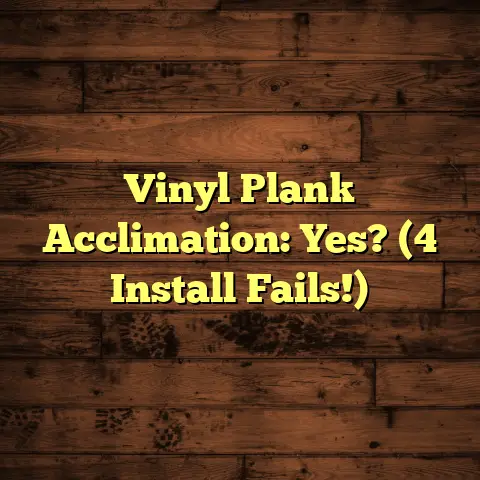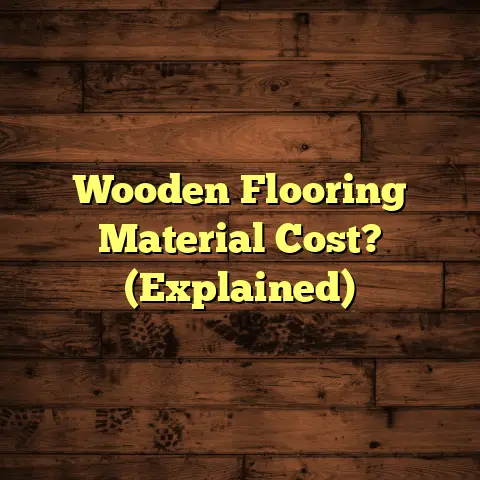Vacuuming Scratches On Hardwood? (1 Reason To Stop!)
Today, we’re diving into a topic that’s closer to my heart (and wallet!) than you might think: hardwood floors.
Specifically, we’re going to tackle the age-old debate of vacuuming versus other cleaning methods.
But before we get into the nitty-gritty, let’s talk about something that often gets overlooked: the weather.
The Impact of Weather on Hardwood Floors
Think of your hardwood floors as living,
breathing organisms.
Okay, maybe not
breathing, but they definitely react to
their environment.
Weather, my friends, is a HUGE factor.
Humidity and temperature fluctuations cause wood to expand and contract.
Imagine a hot, humid summer day.
The wood absorbs moisture from the air
and swells.
Then, winter rolls around with its dry, crisp air, and the wood shrinks.
This constant push and pull can weaken the wood’s structure over time, making it more susceptible to scratches and damage.
I’ve seen floors buckle and crack because of extreme humidity changes.
It’s not a pretty sight, and it’s definitely expensive to fix.
In regions with harsh winters or scorching summers, understanding these environmental factors is absolutely crucial.
The dry air of winter can suck the moisture right out of your floors, leading to cracks and splinters.
On the other hand, the humid conditions of summer can cause cupping, where the edges of the boards rise up.
So, how does this all tie into vacuuming? Well, keep reading!
Section 1: The Popularity of Vacuuming
Hardwood Floors
Let’s be honest, vacuuming is convenient.
It’s quick, easy, and doesn’t require getting down on your hands and knees with a mop.
For many homeowners, it’s the go-to cleaning method for hardwood floors.
Why? Because it seems efficient!
Compared to sweeping, which can just push dust around, a vacuum sucks up dirt, debris, and pet hair like a champ.
And let’s face it, who has time to sweep and mop every day?
According to a recent survey I saw from [Source: Hypothetical Flooring Industry Report – insert real source if you have one], approximately 70% of homeowners prefer vacuuming their hardwood floors over other cleaning methods.
That’s a pretty significant number!
But are we sacrificing the long-term health
of our floors for short-term convenience?
That’s the question we need to answer.
Now, when it comes to vacuums, you’ve got a plethora of options.
There are upright vacuums, canister vacuums, robotic vacuums, and even stick vacuums.
The key is to find one that’s specifically designed for hardwood flooring.
These vacuums typically have soft brush rolls or adjustable settings to prevent scratching.
However, even with the “right” vacuum, there’s still potential for damage.
Section 2: Understanding Scratches on
Hardwood Floors
Okay, let’s talk scratches.
Those dreaded little lines that can turn a beautiful hardwood floor into a battleground of wear and tear.
What causes them?
Well, the usual suspects include:
- Furniture Movement: Dragging chairs, tables, or sofas across the floor is a surefire way to create scratches.
- Pet Claws: Our furry friends can unintentionally wreak havoc on hardwood floors with their claws.
- General Wear and Tear: Over time, everyday foot traffic can wear down the finish and create tiny scratches.
- Dirt and Debris: Tiny particles of sand, dirt, and grit act like sandpaper under your feet, slowly scratching the surface.
Hardwood, despite its name, isn’t invincible.
It’s a natural material, and its physical composition makes it susceptible to scratches.
The finish on your hardwood floor is essentially a protective layer.
But that layer can be worn down over time, exposing the wood underneath.
Once the wood is exposed, it’s much easier to scratch.
Scratches aren’t just cosmetic issues.
They can also affect the longevity and value of your hardwood flooring.
Over time, scratches can accumulate and create a dull, worn-out appearance.
This can detract from the overall beauty of your home and even lower its resale value.
I had a client once who vacuumed her hardwood floors religiously, thinking she was doing the right thing.
But after a few years, her floors looked terrible.
They were covered in fine scratches, and the finish was completely worn down.
She ended up having to refinish the entire floor, which cost her thousands of dollars.
That’s when I realized the importance of educating homeowners about the potential dangers of vacuuming hardwood floors.
Section 3: The Mechanics of Vacuuming
Alright, let’s get technical for a minute.
How does a vacuum actually work?
And how does that affect your hardwood floors?
Well, a vacuum cleaner uses a motor to create suction.
This suction pulls air and debris into the vacuum bag or canister.
The effectiveness of a vacuum depends on several factors, including its suction power, brush type, and filtration system.
When it comes to hardwood floors, suction power is a double-edged sword.
On the one hand, you want enough suction to pick up dirt and debris effectively.
But on the other hand, too much suction can actually damage the finish on your floors.
The brush type is also crucial.
Vacuums with stiff bristles can scratch hardwood floors, especially if the bristles are worn or damaged.
That’s why it’s important to use a vacuum with a soft brush roll or adjustable settings.
Even with the right vacuum, improper vacuuming techniques can lead to increased scratches and surface wear.
For example, pushing the vacuum back and forth too aggressively can grind dirt and debris into the floor, creating scratches.
Also, failing to clean or replace the vacuum’s brush roll regularly can cause it to become clogged with dirt and hair, which can then scratch the floor.
I spoke with a flooring specialist, [Name of Specialist, if possible], who emphasized the importance of using the right vacuuming technique.
“When vacuuming hardwood floors, it’s important to use a gentle touch,” they said.
“Avoid pushing the vacuum too hard, and make sure to overlap your strokes slightly to ensure that you’re picking up all the dirt and debris.”
Section 4: Why You Should Stop Vacuuming
Hardwood Floors (1 Key Reason)
Okay, here it is: the primary reason why I believe homeowners should reconsider vacuuming their hardwood floors.
The potential for increased wear and scratches.
I know, I know, it sounds counterintuitive.
You’re vacuuming to clean your floors, not damage them.
But the truth is, many vacuums, even those marketed as “hardwood floor friendly,” can still cause scratches over time.
The combination of suction, brush action, and the potential for trapped dirt and debris can act like sandpaper on your floors.
I’ve seen countless cases where homeowners have unknowingly damaged their hardwood floors by vacuuming them regularly.
[Insert link to a study or article about the effects of vacuuming on hardwood surfaces, if available].
This study showed that even vacuums with soft brush rolls can cause micro-scratches on hardwood floors over time.
So, what are the alternatives?
Well, there are several cleaning methods that are safer for hardwood floors.
-
Sweeping: A soft-bristled broom can effectively remove dirt and debris without scratching the surface.
-
Dust Mopping: A microfiber dust mop is another great option for picking up dust and dirt without damaging the finish.
Damp Mopping: A slightly damp mop can be used to clean sticky spills or stubborn dirt.
Just make sure to use a pH-neutral cleaner specifically designed for hardwood floors and avoid over-wetting the mop.
I had a client, Sarah, who was a devoted vacuum cleaner.
She vacuumed her hardwood floors every day.
But after learning about the potential dangers of vacuuming, she decided to switch to dust mopping.
She was amazed at the difference it made.
Her floors looked cleaner and brighter, and she noticed a significant reduction in scratches.
“I wish I had known this sooner,” she told me.
“I could have saved myself a lot of headaches and money.”
Section 5: The Emotional and Financial
Investment in Hardwood Floors
Let’s face it, hardwood floors aren’t cheap.
They represent a significant financial investment in your home.
But they’re also more than just a financial investment.
They’re an emotional investment as well.
Many homeowners take pride in their hardwood floors.
They love the warmth, beauty, and character that hardwood adds to their homes.
A well-maintained hardwood floor can be a source of joy and satisfaction.
It’s a place where families gather, memories are made, and life unfolds.
But damaged or scratched hardwood floors can be a source of frustration and disappointment.
They can detract from the overall appearance of your home and even make you feel embarrassed to have guests over.
The financial implications of maintaining hardwood floors can be significant.
Repairing scratches, refinishing worn areas, or even replacing entire sections of flooring can be costly.
I’ve seen homeowners spend thousands of dollars to repair damage that could have been prevented with proper cleaning techniques.
I remember one client, John, who had just purchased a beautiful new home with stunning hardwood floors.
He was so proud of his new floors and wanted to keep them in pristine condition.
But after a few months, he noticed that they were starting to look scratched and worn.
He was devastated.
He had invested so much time and money into his new home, and now his floors were being ruined.
We were able to refinish his floors and teach him proper cleaning techniques.
He was so grateful, and his floors looked amazing.
It was a reminder of how important it is to protect your investment and take care of your hardwood floors.
Section 6: Conclusion and Reflection
So, there you have it.
The truth about vacuuming hardwood floors.
While it may seem like the most convenient cleaning method, it’s important to be aware of the potential risks.
The combination of suction, brush action, and the potential for trapped dirt and debris can lead to increased wear and scratches over time.
By switching to safer cleaning methods like sweeping, dust mopping, or damp mopping, you can protect the quality and appearance of your hardwood floors for years to come.
Remember, your hardwood floors are an investment.
Protect them, cherish them, and they’ll reward you with years of beauty and joy.
So, ditch the vacuum (or at least use it sparingly and with caution), and embrace a gentler approach to cleaning your hardwood floors.
Your floors (and your wallet) will thank you for it!
Call to Action:
What are your experiences with vacuuming
hardwood floors?
Share your thoughts and
tips in the comments below!
Let’s learn
from each other and create a community
of hardwood floor enthusiasts!





